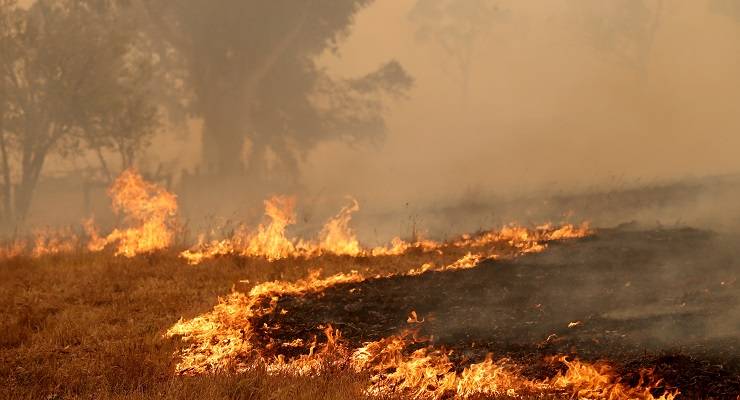
Here we go again. A record-breaking heatwave has left eastern Australia sweltering, Sydney had its hottest November night on record and we saw a smattering of fires across NSW and Queensland. This past weekend has brought back painful memories of last year’s black summer.
It was the first big heatwave of the summer, and the first time since last season’s devastation that widespread high fire danger returned to much of the country. The heatwave also comes just weeks after a royal commission into the bushfires released its final report. With 80 recommendations, it’s given the federal government plenty of pointers about how future bushfires catastrophes could be managed and mitigated.
So, how well are they doing so far?
What the government said
On the face of it, the Morrison government’s response to the report seems positive.
It’s accepted all 80 recommendations, and seems to be making headway particularly on issues like speeding up the responsiveness of the defence force. And thanks to the national cabinet — set to continue after the COVID-19 pandemic — there’s now a framework for ministers and leaders to discuss fire management.
But dig deeper and the response looks a little vague. The government has “supported” 33 recommendations, and supported another 25 “in principle”. The rest are left to the states.
For some recommendations, like establishing a national disaster resilience and recovery body, the government has committed to action by July next year. For most others, including updating the Australian warning system, there’s no clear plan.
Ken Thompson, a former deputy commission of NSW Fire and Rescue and a member of Emergency Leaders for Climate Action, says the government’s response is unclear.
“Recommending something in principle is just another way of saying you’re not doing anything,” he says.
“What the government needs to do is provide a response to each of those recommendations. We need to know what’s the timeline, who’s responsible for making sure they’re implemented.”
The royal commission follows a spate of separate state-based bushfire inquiries held over the last 12 months. And there’s the potential for recommendation exhaustion — too many reams of reports and inquiries and working papers that become easy to ignore.
“We’ve had so many royal commissions and so many where the recommendations are ignored and lost to the passages of history,” Thompson says.
“Unless those recommendations are actually acted on, they become worthless.”
Are we ready for more fires?
Perhaps it’s too much to expect the Morrison government to have made real progress on the recommendations of a report released just weeks ago. But it’s now been almost a year since Australia started choking under a haze of bushfire smoke.
If another catastrophic fire season hit, would we be ready? Thompson says it’s unlikely: “I would have to say we’re probably no more prepared than we were last time.”
And the bad news is we’re only getting less prepared. As climate change gets away from us, fire seasons are going to get bigger, longer and less predictable. We’ve been getting warnings about that for decades, which have fallen largely on deaf ears in Canberra.
Thompson says there’s a hostility towards the science on climate change, particularly in the Coalition, which is making it a lot harder for fire and emergency services to do their jobs.
“To get additional funding, they [fire and emergency services] need to put in really well-argued business cases, and a big part of that is fitting in with government policy.”
He says that when governments don’t have clear policy on climate, it’s a lot harder for fire services to, say, make the case for getting another plane.
The government’s “in principle” support for the recommendations is a good start, but it seems like we’re going to be playing catch-up until we take climate change seriously.








I’d be willing to bet that SmoKo was relying on a wet la Nina to deal with the fire thangy.
It will be interesting watching how socially distanced volunteer firies manage in a couple of weeks.
Watch them spin the bushfire season as unprecedented and unexpected.
All fires from now on will be described- like last year – by all TV channels as a law and order issue of course caused probably by those green lefty suburban arsonists !
Firstly, it was more than a year ago. Mid north coast NSW and southern Qld we’re going up in smoke in August and September 2019. Latter end of November the Gospers Mountain fire had blanketed most of the central coast and Sydney in a brown pall I have never seen before. That would run until life saving rains unexpectedly and luckily hit in February.
And Scomo is doing his best to avoid the issue of buying planes and helicopters, saying it is a states issue. So where’s our national cabinet, dingbat.
He is nothing more than marketing spin.
We’re exposed to bushfires and other climate change impacts but we’re not so much worried about that as the dysfunctional twisitng and denials of our politicians and governments. Not only do they appear unready, they don’t appear to care about the severe problems we may experience. Lose house, suffer burns, trapped for days/weeks without help, no food, cannot escape, covid resurgence, no fresh water – no matter where we look we see little or no attempt to prepare to provide safe and secure havens for our disparate population. Like anyone approaching the end of life, we know we cannot deal with some things. But the governemnts, who we are forced to fund and whose ample wages and benefits we must provide, they are the reason we’re worried because it looks very much as though they won’t be there when we need help the most.